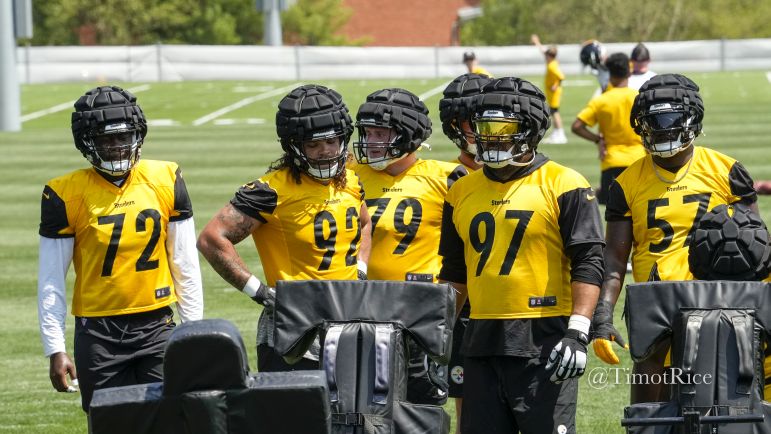The Steelers kept eight defensive linemen on their initial 53-man roster. That stirred a lot of conversation within Steelers Nation since they normally have kept six on the roster in the past. As I was drafting my annual Former Steelers Around the NFL article, I noticed that there was no standard number of players assigned to position groups throughout the league.
I decided to compare the Steelers’ Week 1 roster against the position groups on other teams just to see if eight defensive linemen deviated significantly from other teams. Every team carries three specialists: a kicker, a punter, and a long snapper. So, how do the teams allocate the remaining 50 positions among the offensive and defensive position groups?
Offensive Position Groups
The NFL has become such a passing league that I thought most offensive position groups would have similar numbers of running backs, wide receivers, and tight ends. I thought that the fullback position was limited to just a couple of teams. Here is what I found:
| QB | RB | FB | WR | TE | OL | Total | |
| AFC | |||||||
| Steelers | 3 | 3 | 0 | 5 | 4 | 9 | 24 |
| Bills | 2 | 3 | 1 | 5 | 3 | 9 | 23 |
| Dolphins | 2 | 4 | 1 | 5 | 4 | 9 | 25 |
| Patriots | 3 | 3 | 0 | 6 | 3 | 10 | 25 |
| Jets | 2 | 4 | 0 | 6 | 3 | 10 | 25 |
| Ravens | 2 | 2 | 1 | 6 | 3 | 10 | 24 |
| Bengals | 2 | 3 | 0 | 6 | 5 | 9 | 25 |
| Browns | 3 | 3 | 0 | 6 | 2 | 10 | 24 |
| Texans | 2 | 5 | 0 | 7 | 3 | 9 | 26 |
| Colts | 3 | 3 | 0 | 6 | 4 | 10 | 26 |
| Jaguars | 2 | 3 | 0 | 6 | 3 | 10 | 24 |
| Titans | 2 | 3 | 0 | 6 | 5 | 9 | 25 |
| Broncos | 3 | 4 | 0 | 5 | 4 | 9 | 25 |
| Chiefs | 2 | 2 | 1 | 7 | 4 | 10 | 26 |
| Raiders | 2 | 4 | 0 | 6 | 3 | 9 | 24 |
| Chargers | 3 | 4 | 0 | 7 | 3 | 9 | 26 |
| NFC | |||||||
| Cowboys | 3 | 3 | 1 | 6 | 4 | 9 | 26 |
| Giants | 3 | 3 | 0 | 6 | 3 | 9 | 24 |
| Eagles | 3 | 3 | 0 | 5 | 2 | 9 | 22 |
| Commanders | 3 | 3 | 0 | 7 | 4 | 9 | 26 |
| Bears | 2 | 4 | 1 | 6 | 3 | 10 | 26 |
| Lions | 2 | 4 | 0 | 4 | 3 | 10 | 23 |
| Packers | 2 | 3 | 0 | 6 | 3 | 10 | 24 |
| Vikings | 3 | 2 | 1 | 6 | 3 | 9 | 24 |
| Falcons | 2 | 4 | 0 | 5 | 3 | 9 | 23 |
| Panthers | 2 | 3 | 0 | 5 | 4 | 10 | 24 |
| Saints | 4 | 3 | 1 | 6 | 3 | 8 | 25 |
| Buccaneers | 2 | 3 | 0 | 5 | 4 | 9 | 23 |
| Cardinals | 2 | 4 | 0 | 6 | 4 | 9 | 25 |
| Rams | 2 | 4 | 0 | 6 | 3 | 8 | 23 |
| 49ers | 3 | 4 | 1 | 7 | 3 | 8 | 26 |
| Seahawks | 2 | 3 | 0 | 6 | 4 | 11 | 26 |
| Median | 2 | 3 | 0 | 6 | 3 | 9 | 25 |
Couple Surprises
I had a couple of surprises when going through the rosters. First, 19 teams carried only two quarterbacks going into Week 1 despite the rule requiring the emergency quarterback to be on the 53-man roster. Plus, nine teams have a fullback on their roster. I don’t have Connor Heyward listed as a fullback since Pittsburgh uses him in so many ways. But that could be a tenth team. 28 of 32 teams had 3 or 4 running backs. 31 of 32 teams had 5-7 receivers. 28 teams had 3 or 4 tight ends. Two teams have five and two just two tight ends. 28 teams have 9 or 10 linemen. The smallest lineman group had 8 (3 teams). And one with 11 linemen.
Pittsburgh falls into the norms. But has one less receiver than the median of all teams. And one extra tight end. This reflects the tendencies of previous Arthur Smith-designed offenses.
Defensive Position Groups
I believed that defensive position groups would have more deviation due to some teams using the 3-4 versus the 4-3 as their base defense. But most teams probably vary their offenses with a mix of base, nickel, and dime packages based on the game situation. I grouped outside linebackers (edge rushers) with middle or inside linebackers together. Same with cornerbacks and safeties. Here is what I found:
| DL | LB | DB | Total | |
| AFC | ||||
| Steelers | 8 | 8 | 10 | 26 |
| Bills | 9 | 7 | 11 | 27 |
| Dolphins | 5 | 10 | 10 | 25 |
| Patriots | 6 | 8 | 11 | 25 |
| Jets | 10 | 5 | 10 | 25 |
| Ravens | 5 | 10 | 11 | 26 |
| Bengals | 10 | 5 | 10 | 25 |
| Browns | 9 | 6 | 11 | 26 |
| Texans | 8 | 6 | 10 | 24 |
| Colts | 10 | 5 | 9 | 24 |
| Jaguars | 11 | 6 | 9 | 26 |
| Titans | 4 | 11 | 10 | 25 |
| Broncos | 6 | 8 | 11 | 25 |
| Chiefs | 10 | 5 | 9 | 24 |
| Raiders | 9 | 7 | 10 | 26 |
| Chargers | 6 | 8 | 10 | 24 |
| NFC | ||||
| Cowboys | 9 | 5 | 10 | 24 |
| Giants | 5 | 10 | 11 | 26 |
| Eagles | 8 | 10 | 10 | 28 |
| Commanders | 8 | 5 | 11 | 24 |
| Bears | 10 | 5 | 10 | 25 |
| Lions | 7 | 8 | 11 | 26 |
| Packers | 11 | 5 | 10 | 26 |
| Vikings | 6 | 9 | 11 | 26 |
| Falcons | 8 | 9 | 9 | 26 |
| Panthers | 5 | 10 | 11 | 26 |
| Saints | 10 | 6 | 9 | 25 |
| Buccaneers | 6 | 10 | 11 | 27 |
| Cardinals | 6 | 9 | 10 | 25 |
| Rams | 6 | 10 | 11 | 27 |
| 49ers | 8 | 6 | 10 | 24 |
| Seahawks | 7 | 8 | 9 | 24 |
| Median | 8 | 8 | 10 | 25 |
More Deviation
As I expected, there appears to be more deviation among defensive position groups. The defensive line groups contained as few as four and up to eleven defensive ends and tackles. The sweet spot is between 6 and 9 linemen. Linebackers had a similar spread. The least was five linebackers on eight rosters. The most was the Titans with 11 linebackers. All of the secondaries contained 9-11 defensive backs. That is required to try to stop the prolific passing offenses. But the big decision is whether to load up beef the defensive line or to have more mobility with a larger linebacker corp.
Pittsburgh’s distribution is right in line with the median: eight linemen, eight linebackers, and 10 defensive backs. Is this a conscious decision to keep run stoppers fresh with a rotation?
Conclusion
The distribution of players among the position groups will change as the season progresses. I wonder if more teams will seek to sign a third quarterback.
Perhaps I will break this down into subgroups such as safeties, cornerbacks, and interior linemen versus offensive tackles in the future. But this gave a quick snapshot that showed Pittsburgh well within the norms.
Your Song Selection
I always like to include a bit of music. Don’t know whether it’s important that the Steelers roster composition is normal. But here is Am I Normal performed by Virginia David.








